
At last environment watchdog gets its teeth
The Central Environmental Authority will be issuing a gazette introducing standards to be complied with regard to industrial gaseous emissions by factories.
The Government has proposed to take stern legal action against industries releasing gases harmful to the environment without adhering to the stipulated standards in terms of the quantities to be released and the air quality to be maintained at all times.
Those engaged in the improper disposal of waste into water bodies and anyone emitting sounds at decibel levels harmful to the environment are presently being dealt with under the National Environmental Act.
Director General of the Authority, K.H. Muthukudaarachchi explained that power plants, those operating industrial boilers and furnaces such as those in the metal industry, the recycling industry, and those engaged in smelting and fabrication were the heaviest polluters as far as the industrial sectors were concerned.
Subsequent to the issuing of the gazette, a national and island-wide programme would be implemented.
While the Authority will conduct quarterly inspections by way of visits to factories island-wide, the law also allows them to conduct raids.
“The gazette has been drafted and sent to the Legal Draftsman’s Department for approval. Industrial treatment plants have to be maintained as per the current law and sound levels too must be maintained at the prescribed levels,” Muthukudaarachchi further said.
Source – 31/12/2016, The Nation, see more at – http://nation.lk/online/2016/12/31/at-last-environment-watchdog-gets-its-teeth.html
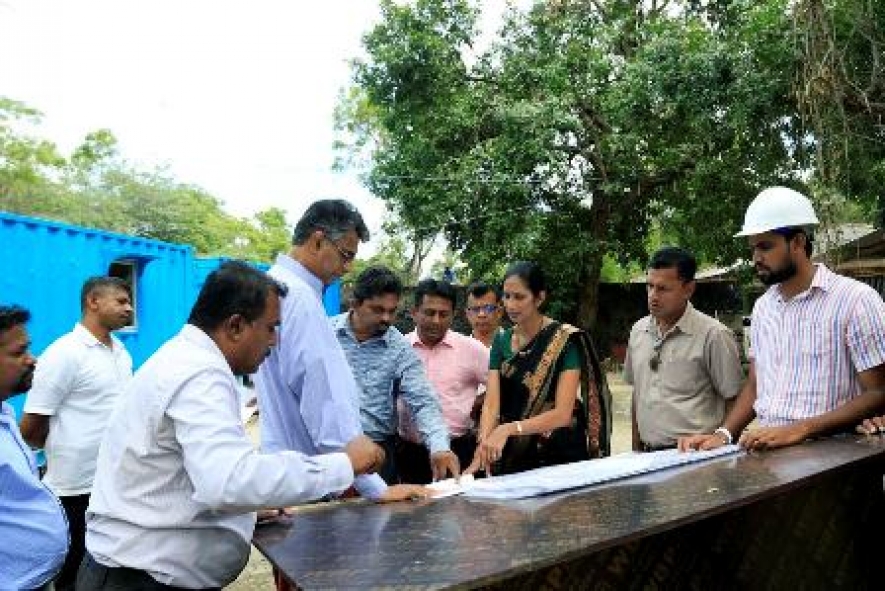
Polonnaruwa to be developed under ‘Sukhitha Purawara’ initiative
A special discussion on the development of Polonnaruwa was held yesterday (26th Feb.) at the CECB, Polonnaruwa under the patronage of Minister of Megapolis and Western Development Patali Champika Ranawaka.
Protecting the history of ancient Polonnaruwa, the development project will be implemented by the Urban Development Authority (UDA) under the ‘Sukhitha Purawara’ initiative. Polonnaruwa will be developed under three phases as the ancient city, Kaduruwela Financial City, and the new town administration city.
The minister instructed the officials to draft a regular program for maintenance before every development program is implemented and to be implemented. Further, the attention was also drawn towards solid waste management, energy management, and traffic congestion. A program should also be implemented to harvest the rain water and use for the public needs.
The minister further said that, the urban development programs implemented previously have been destroyed at present due to the non-availability of a program to maintain them, but the present government is being accused in that regard.
The officials were further instructed by minister Ranawake to finish the basic development programs of Polonnaruwa development project by 2020.
Sourc – 27/02/2017. Ceylon Today, See more at – http://www.ceylontoday.lk/article20170101CT20170331.php?id=4173
Dry zone small tank revival seen mitigating drought impact
Private sector investments have been encouraged to revive small tank cascade systems in the country’s dry zone to mitigate the impact of a severe drought, which has deprived almost a million people of drinking water and cut rice output.
Most long-term recommendations to mitigate the impact of disasters like drought are about overall disaster risk reduction, said Visaka Hidellage, Deputy Country Representative of the United Nations Development Programme.
The island came out of serious floods in 2016 and then went straight into a drought, she told a forum on drought impact organised by the Asia Pacific Alliance for Disaster Management Sri Lanka (A-PAD Sri Lanka).
“When there are floods, everyone is concerned about getting the water out rather than storing it for a drought,” she said. “There’s a very direct link between drought and floods.”
Disaster risk reduction measures for drought management include the revival of the small tank cascade systems in the dry zone, Hidellage said.
“But rehabilitation of tanks in isolation is not the answer – we need a system-wide approach,” Hidellage said.
A 27 tank cascade system rehabilitated in 2015/16 in Kurunegala had helped farmers continue cultivation of rice and other crops despite the drought, and could be replicated elsewhere.
In Kurunegala. tanks were filled with water so farmers were able to work and cultivation continued into the next season.
“Not just paddy but alternative crops can be looked at. We need to think long term for an effective disaster risk reduction strategy,” Hidellage said.
The work was started in 2015, and by mid-2016, some tanks in the cascade system were completed, so water got filled and despite a failed crop elsewhere, people were able to cultivate.
Investments in tank rehabilitation could be a way of channelling drought relief to farmers, she said.
“The UN wants to start a mapping exercise of all tanks in 12 districts – small tank cascades – to give guidance to those who want to invest in drought risk reduction,” Hidellage said. (ECONOMYNEXT)
Source – 27/02/2017, The Island, See more at – http://www.island.lk/index.php?page_cat=article-details&page=article-details&code_title=161065
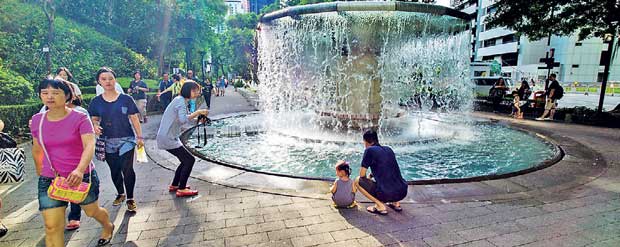
Green cities are not just for the elite
Green cities have become a key goal of urban development. They are environmentally friendly, provide clean water, protect green space and offer an enhanced public experience. However, they’re not perfect. In fact, some of the different needs of citizens may have been neglected amid all the attention lavished on green cities. A green city in many real-life cases is neither green everywhere, nor green for everyone. Also, a green city neither guarantees an economically strong city nor a
However, they’re not perfect. In fact, some of the different needs of citizens may have been neglected amid all the attention lavished on green cities. A green city in many real-life cases is neither green everywhere, nor green for everyone. Also, a green city neither guarantees an economically strong city nor a liveable place for people of all income classes. While the reference to income classes may sound like an old debate about class war, inequality between citizens of different financial means should be acknowledged. A city that aims to provide for the diverse needs of its population has to formulate a correspondingly diverse urban development agenda.
Seen from the perspective of urban dwellers of different socio-economic status, there are five urban development objectives that can be considered as ascending stages on a scale of liveability. First, in its most basic form, urban life needs to ensure a livelihood for citizens. Second, it should enable accessibility, allowing its residents to participate fully in daily urban life. Third, urban life should be affordable, ensuring that urban infrastructure, such as housing and urban services, such as healthcare, are affordable for citizens. Fourth, it requires resilience, enabling people to withstand social threats such as crime or environmental impacts like extreme weather events. Finally, at the highest stage, urban life has to provide for liveability, which allows people to fully enjoy what their city has to offer.
Focus on citizen needs
One can argue that some city governments have focused a lot of attention and resources toward developing environmentally sustainable cities that offer residents spaces to enjoy and thrive in. Although this is laudable and the five urban development objectives are not mutually exclusive, this policy focus might not deliver what many citizens most urgently need in developing Asia – shelter and a decent income.
This discrepancy is evident in the widespread housing insecurity and lack of economic opportunities we can see in many cities across the region. If a person’s main concern is to find a place to stay and to sustain a life for themselves and their families, a refurbished park in the city centre won’t do.
I formulate this in a provocative, obviously simplified way, not to discredit a green urban development agenda but to underscore that local governments have many other objectives to consider besides developing environmentally friendly cities. And even with regard to the green or other parts of the urban agenda, local governments have to pay special care to ensure that benefits are enjoyed by the whole urban population or at least a large majority.
Local solutions for inclusive green cities People of different socio-economic status should be able to benefit from their cities in physical, economic, environmental and social terms. The first three premises of a good urban life—basic livelihood, accessibility and affordability—need to be delivered. This doesn’t mean that resilience and liveability—the other two of the five urban development objectives—are any less worthwhile as goals. But if you don’t have livelihood, can’t participate fully in the city and can’t afford to live there, the final two objectives are attainable only by a small urban elite.
Local governments have to carefully evaluate which thematic areas are most relevant to the daily needs of their citizens. If a city lacks access to clean water and sanitation, hospitals, or public safety, the urban development agenda should reflect this – even if it diverges from current urban planning trends
Localized urban development policies should identify and reflect cross-sectoral benefits. For example, an economic growth programme should aim to improve a city’s competitiveness and also provide job opportunities to a broader array of citizens so they can afford housing, medical bills or the entrance fee to a cultural event.
Only then can green urban development have a genuine and positive impact on the lives of all citizens.
(Renard Teipelke is Consultant, Sustainable Development and Climate Change Department at the Asian Development Bank)
Source – 28/02/2017,Daily Mirror, See more at: http://www.dailymirror.lk/article/Green-cities-are-not-just-for-the-elite-124585.html#sthash.O0gjNkZZ.dpuf
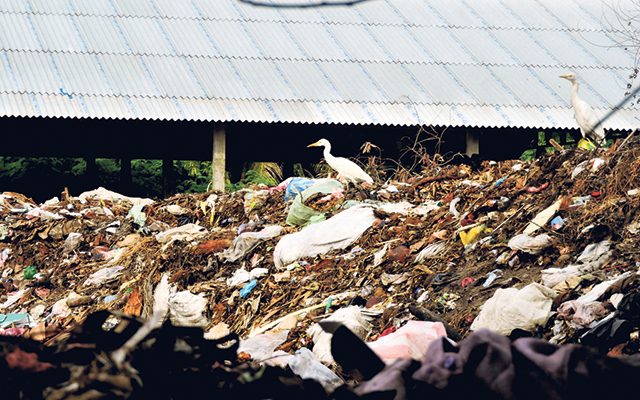
Dumping garbage on people
For the people living in Ekala,Ja Ela,garbage has become a critical issue in their life, since their environs have been subjected to big time garbage dumping. The compost plant belonging to Ja Ela Pradeshiya Sabha is located in Ekala behind the Heartland Residencies, where the garbage collected from the Ja Ela Pradeshiya Sabha is recycled to make compost. In addition, lands in Ekala have been identified to relocate the Meethotamulla garbage dump.
The compost plant belonging to Ja Ela Pradeshiya Sabha is the site where garbage collected in the area is brought and sorted into biodegradable and non biodegradable material. A worker who wished to remain anonymous said, on average, about seven tractor loads of garbage reach the site per day, where, degradable and non degradable material in almost equal quantities, are sorted. The degradable material is used to make compost and the non degradable material is sent to the cement plant in Puttalam.
The degradable material is cured for three months until compost is formed before packing. The plant is located on a land of about three acres and employs 10 workers and two watchers who are given safety masks, boots and uniforms by the government, in addition to medical checkups roughly every six months.
But this apparently benevolent compost plant has its dark side, says residents of Heartland Residencies as well as the villagers from the area. Diriya PuravasiSamithiya, Secretary, MMT Rajarathna told us the compost plant is actually located on the border of Ja Ela and Katana Pradeshiya Sabhas. “Although it belongs to Ja Ela, it borders Kalu Ela, beyond which lies the villages of Weliganeliya, Gurugewatta, Midlandwatta and Kasagahawatta, where the wind wafts in a strong odour. During the monsoons, wind carries the stench as far as 100 metres”.
“Another persistent problem are flies and mosquitoes from the garbage dumped in the compost plant, along with dogs dragging the garbage around, birds carrying dead and decaying matter and dropping them in wells. Our letters of protest to all the officials involved from the President to the Grama Niladari of the area are of no avail,” he adds.
According to him, Central Environmental Authority (CEA), Gampaha District Office, in feasibility study had recommended the garbage dumped be relocated. They have also recommended closing the compost site on three sides to minimize the stench and prevent collapse and to spray for insects. “The PHI verbally promised that this would be done, but so far no action has been taken. What I want to know is how practicalit is, to dump so much garbage within such a small space, since this would have adverse impact on the health of future generations,” he states.
“We want to breathe freely,” declared one resident of the Heartland Scheme, who wished to remain anonymous. The stench from the piles of garbage makes the residents of the area nauseous and suffocating, especially during night time, when it is strongest.
Udeni Ranatunge, Resident of Heartland Residencies, commented that the land where the compost plant is, has been donated to Pradeshiya Sabha by their company as a CSR project to build a cemetery or a children’s playground. Now the garbage from Ragama, Kandana, Ja Ela, Batuwatta and even the garbage from Ragama hospital including syringes and blood stained cotton wool are dumped at the site. It was first a pit of water, which has now filled with garbage.
“We can’t stay here. Flies perch on the clothes we put on lines to dry. Once they fly off, there are maggots on the clothes. We now eat inside mosquito nets because there are so many flies,” she says. The issue is somewhat reduced, as pesticides are used at the compost plant. After complaining to the police, a solution was promised to them by February 15.
“What they did was burying all the garbage and covering with soil. We drink water from tube wells, we’re scared we might catch some sort of disease.”
Heartland Welfare Association, Secretary, Daya Chandrapala says, after the police complaint, they had a discussion with the  Authorities from PradeshiyaSabha, which indicated the compost plant would not be removed. “What they are actually doing is, dumping garbage, using the guise of compost plant,” he says. He disclosed that the residents are preparing for courts in case a solution is not provided by February 15.
Authorities from PradeshiyaSabha, which indicated the compost plant would not be removed. “What they are actually doing is, dumping garbage, using the guise of compost plant,” he says. He disclosed that the residents are preparing for courts in case a solution is not provided by February 15.
“Children get coughs and other lung problems, plusan epidemic of skin diseases,” says Srinath De Silva, another resident. According to him the presence of worms is due to rotten meat from the markets found among the garbage. “This is what attracts cranes and crows. Even the PHI, who is supposed to look after our health, is trying to please the Pradeshiya Sabha.”
Fathima Zainab, a young mother from the area said that the children are falling ill and it is difficult to keep flies off her young  child’s food. “Because of the smell, we got a burning sensation similar to gastritis; my family had to take medicine. We are living on rent, we have two more months to stay, but we are going to leave.
child’s food. “Because of the smell, we got a burning sensation similar to gastritis; my family had to take medicine. We are living on rent, we have two more months to stay, but we are going to leave.
Ja Ela Pradeshiya Sabha, Secretary,Manjula Samanthi commented that there are no flies or worms in the area and that cranes take care of the flies. “I went to visit the plant today and it is a compost plant that generates a good income. Polythene is baled here. There is no problem,” she says.
Residents of Ekala have also been under tension due to the proposal to relocate Meetotamulla garbage dump to Othe Kale, Ekala. Ruvini Jayasinghe, Resident of Matthew Mawatha said, this site is selected being the lowest tender received by the Colombo Municipal Council, at the tender for a land to dispose garbage. The land, being a marsh, is flood prone. “This would adversely affect if the garbage dumping sites are re-located to Othe Kale. Areas including Makavita, Kotugoda, Bolanda,Koraleliyawatta,Vishakawatta, Matthew Mawatha, Pansala Para, Ekala Karmika Janapadaya, Gampaha Para, Nivasipura, Millennium City, Raddolugama and Seeduwa. This would affect our ground water supply and pollute well water. In addition, this area floods every year, carrying garbage inside our houses with the flood water”. She also discloses that the Kotugoda Ela boarding this proposed land, falls in to the Negombo Lagoon, creating a serious threat to the ecosystem.”
The odour is not the least of their concerns. “It was reported that people in Meethotamulla area contracted skin diseases, and other serious ailments due to the garbage fills. Child mortality was high in that area. Knowing this, politicians are still planning to go forward without thinking of the people, after all the protesting. There is no difference between people of Ekala and people of Meetotamulla,” she states.
She further adds that the owner of the proposed land is speculated to earn 30 million rupees per month from the Colombo Municipal Council, as the rent for the land. “We live everyday, thinking for how many days we will be able to breathe without stink. It is better to die than to live in a garbage dump. There is no point in living if we cannot be free in our homes,” she declared.
Archbishop Malcolm Cardinal Ranjith has requested the government to relocate or alternatively recycle instead of dumping at Ekala, Ja Ela, a highly populated area, subject to flooding. He also stressed the environmental impact on the Negombo lagoon.
Authorities from Central Environmental Authority were not available for comment.
A long-term garbage disposal mechanism, is the answer if this issue is to be tackled successfully. Relocating garbage dumps is far from a pragmatic solution. If the solution is recycling, then there is the necessity to ensure that there are no adverse effects to human health as well as the environment, in the process.

Source – 27/02/2017,Nation , See more at – http://nation.lk/online/2017/02/04/dumping-garbage-on-people.html

Nature Makes You Kinder, Happier & Creative
Last Friday’s “Health & Society” spoke of how nature helps people relieve stress and live a healthier life. Dr. Danielle Shanahan of University of Queensland recommends a “minimum dose of nature” where she proposes people to visit local parks at least for half an hour every week. Her study found that this could reduce the prevalence of high blood pressure and depression in the community by nine and seven percent respectively.
We also spoke of “Nature-Deficit Disorder”, a term that was first coined by the author Richard Louv in his best-seller “Last Child in the Woods: Saving Our Children from Nature-Deficit Disorder” (in 2005). The reasons cited for this newly described phenomenon include the proliferation of electronic communications, poor urban planning, disappearance of open space, increased street traffic, diminished importance of the natural world in public and private education and parental fear magnified by news on violence in open spaces. An expanding body of scientific evidence suggests that nature-deficit disorder contributes to a diminished use of the senses, attention difficulties, obesity and higher rates of emotional and physical illnesses.
Further, we quoted the American writer Florence Williams and her latest book “The Nature Fix”, which summarized a number of researches on the intricate connection between the natural world and its impact on health, creativity, and happiness. Through her best-seller, Williams makes a strong case for incorporating more green spaces into our lives in order to improve personal and societal well-being. She summed up with a simple prescription for better health associated with nature, which goes, “Go outside, often, sometimes in wild places. Bring friends or not. Breathe.”
Dr. David Strayer, professor in Neural Science at the Department of Psychology, University of Utah, USA too has come up with more compelling scientific evidence on this intricate interaction between nature and human health and wellbeing.
The Greater Good Science Centre (GGSC) at University of California, Berkley, a foremost institution on mental health and wellbeing quoted Dr. Strayer saying, “Now we are seeing changes in the brain and changes in the body that suggest we are physically and mentally more healthy when we are interacting with nature.”
But the flip side of the coin is that we live in a society where people spend more and more time indoors and online—especially children. Findings on how nature improves our brains brings added legitimacy to the call for preserving natural spaces—both urban and wild—and for spending more time in nature in order to lead healthier, happier, and more creative lives.
GGSC chroniclizes the ways scientists are showing how being in nature affects our brains and bodies.
Being in nature decreases stress
It’s clear that hiking—and any physical activity—can reduce stress and anxiety. But, there’s something about being in nature that may augment those impacts.
In a recent experiment conducted in Japan, participants were assigned to walk either in a forest or in an urban center (taking walks of equal length and difficulty) while having their heart rate, heart rate variability, and blood pressure measured. The participants also filled out questionnaires about their moods, stress levels, and other psychological measures.
Results showed that those who walked in forests had significantly lower heart rates and higher heart rate variability (indicating more relaxation and less stress), and reported better moods and less anxiety, than those who walked in urban settings. The researchers concluded that there’s something about being in nature that had a beneficial effect on stress reduction, above and beyond what exercise alone might have produced.
kwk-1.jpg) In another study, researchers in Finland found that urban dwellers who strolled for as little as 20 minutes through an urban park or woodland reported significantly more stress relief than those who strolled in a city center.
In another study, researchers in Finland found that urban dwellers who strolled for as little as 20 minutes through an urban park or woodland reported significantly more stress relief than those who strolled in a city center.
The reasons for this effect are unclear; but scientists believe that we evolved to be more relaxed in natural spaces. In a now-classic laboratory experiment by Roger Ulrich of Texas A&M University and colleagues, participants who first viewed a stress-inducing movie, and were then exposed to colour/sound videotapes depicting natural scenes, showed much quicker, more complete recovery from stress than those who’d been exposed to videos of urban settings.
These studies and others provide evidence that being in natural spaces— or even just looking out of a window onto a natural scene— soothes us and relieves stress.
Nature makes you happier and less brooding
Hiking in nature makes us feel happier, and decrease stress. But, Gregory Bratman, of Stanford University, has found evidence that nature may impact our mood in other ways, too.
In one 2015 study, he and his colleagues randomly assigned 60 participants to a 50-minute walk in either a natural setting (oak woodlands) or an urban setting (along a four-lane road). Before and after the walk, the participants were assessed on their emotional state and on cognitive measures, such as how well they could perform tasks requiring short-term memory. Results showed that those who walked in nature experienced less anxiety, rumination (focused attention on negative aspects of oneself), and negative effects, as well as more positive emotions, in comparison to the urban walkers. They also improved their performance on the memory tasks.
In another study, he and his colleagues extended these findings by zeroing in on how walking in nature affects rumination—which has been associated with the onset of depression and anxiety—while also using functional MRI (fMRI) technology to look at brain activity. Participants who took a 90-minute walk in either a natural setting or an urban setting had their brains scanned before and after their walks and were surveyed on self-reported rumination levels (as well as other psychological markers). Even so, participants who walked in a natural setting versus an urban setting reported decreased rumination after the walk, and they showed increased activity in the subgenual prefrontal cortex, an area of the brain whose deactivation is affiliated with depression and anxiety—a finding that suggests nature may have important impacts on mood.
Bratman believes results like these need to reach city planners and others whose policies impact our natural spaces. “Ecosystem services are being incorporated into decision making at all levels of public policy, land use planning, and urban design, and it’s very important to be sure to incorporate empirical findings from psychology into these decisions,” he says.
Nature relieves attention fatigue and increases creativity
Today, we live with ubiquitous technology designed to constantly pull for our attention. But many scientists believe our brains were not made for this kind of information bombardment, and that it can lead to mental fatigue, overwhelm, and burnout, requiring “attention restoration” to get back to a normal, healthy state.
Strayer is one of those researchers. He believes that being in nature restores depleted attention circuits, which can then help us be more open to creativity and problem-solving.
“When you use your cell phone to talk, text, shoot photos, or whatever else you can do with your cell phone, you’re tapping the prefrontal cortex and causing reductions in cognitive resources,” he says.
In a 2012 study, he and his colleagues showed that hikers on a four-day backpacking trip could solve significantly more puzzles requiring creativity when compared to a control group of people waiting to take the same hike—in fact, 47 percent more. Although other factors may account for his results—for example, the exercise or the camaraderie of being out together—prior studies have suggested that nature itself may play an important role. One in Psychological Science found that the impact of nature on attention restoration is what accounted for improved scores on cognitive tests for the study participants.
This phenomenon may be due to differences in brain activation when viewing natural scenes versus more built-up scenes—even for those who normally live in an urban environment. In a recent study conducted by Peter Aspinall at Heriot-Watt University, Edinburgh, and colleagues, participants who had their brains monitored continuously using mobile electroencephalogram (EEG) while they walked through an urban green space had brain EEG readings indicating lower frustration, engagement, and arousal, and higher meditation levels while in the green area, and higher engagement levels when moving out of the green area. This lower engagement and arousal may be what allows for attention restoration, encouraging a more open, meditative mindset.
It’s this kind of brain activity—sometimes referred to as “the brain default network”—that is tied to creative thinking, says Strayer. He is currently repeating his earlier 2012 study with a new group of hikers and recording their EEG activity and salivary cortisol levels before, during, and after a three-day hike. Early analyses of EEG readings support the theory that hiking in nature seems to rest people’s attention networks and to engage their default networks.
Strayer and colleagues are also specifically looking at the effects of technology by monitoring people’s EEG readings while they walk in an arboretum, either while talking on their cell phone or not. So far, they’ve found that participants with cell phones appear to have EEG readings consistent with attention overload, and can recall only half as many details of the arboretum they just passed through, compared to those who were not on a cell phone.
Though Strayer’s findings are preliminary, they are consistent with other people’s findings on the importance of nature to attention restoration and creativity.
“If you’ve been using your brain to multitask—as most of us do most of the day—and then you set that aside and go on a walk, without all of the gadgets, you’ve let the prefrontal cortex recover,” says Strayer. “And that’s when we see these bursts in creativity, problem-solving, and feelings of well-being.”
Nature helps you to be kind and generous
Whenever I go to places like Yosemite or the Big Sur Coast of California, I seem to return to my home life ready to be more kind and generous to those around me—just ask my husband and kids! Now some new studies may shed light on why that is.
In a series of experiments published in 2014, Juyoung Lee, GGSC director Dacher Keltner, and other researchers at the University of California, Berkeley, studied the potential impact of nature on the willingness to be generous, trusting, and helpful toward others, while considering what factors might influence that relationship.
As part of their study, the researchers exposed participants to more or less subjectively beautiful nature scenes (whose beauty levels were rated independently) and then observed how participants behaved playing two economics games—the Dictator Game and the Trust Game—that measure generosity and trust, respectively. After being exposed to the more beautiful nature scenes, participants acted more generously and more trusting in the games than those who saw less beautiful scenes, and the effects appeared to be due to corresponding increases in positive emotion.
In another part of the study, the researchers asked people to fill out a survey about their emotions while sitting at a table where more or less beautiful plants were placed. Afterwards, the participants were told that the experiment was over and they could leave, but that if they wanted to they could volunteer to make paper cranes for a relief effort program in Japan. The number of cranes they made (or didn’t make) was used as a measure of their “prosociality” or willingness to help.
Results showed that the presence of more beautiful plants significantly increased the number of cranes made by participants, and that this increase was, again, mediated by positive emotion elicited by natural beauty. The researchers concluded that experiencing the beauty of nature increases positive emotion—perhaps by inspiring awe, a feeling akin to wonder, with the sense of being part of something bigger than oneself—which then leads to prosocial behaviors.
Support for this theory comes from an experiment conducted by Paul Piff of the University of California, Irvine, and colleagues, in which participants staring up a grove of very tall trees for as little as one minute experienced measurable increases in awe, and demonstrated more helpful behavior and approached moral dilemmas more ethically, than participants who spent the same amount of time looking up at a high building.
Nature makes you feel more alive
With all of these benefits to being out in nature, it’s probably no surprise that something about nature makes us feel more alive and vital. Being outdoors gives us energy, makes us happier, helps us to relieve the everyday stresses of our overscheduled lives, opens the door to creativity, and helps us to be kind to others.
No one knows if there is an ideal amount of nature exposure, though Strayer says that longtime backpackers suggest a minimum of three days to really unplug from our everyday lives. Nor can anyone say for sure how nature compares to other forms of stress relief or attention restoration, such as sleep or meditation. Both Strayer and Bratman say we need a lot more careful research to tease out these effects before we come to any definitive conclusions.
Still, the research does suggest there’s something about nature that keeps us psychologically healthy, and that’s good to know…especially since nature is a resource that’s free and that many of us can access by just walking outside our door. Results like these should encourage us as a society to consider more carefully how we preserve our wilderness spaces and our urban parks.
And while the research may not be conclusive, Strayer is optimistic that science will eventually catch up to what people like me have intuited all along—that there’s something about nature that renews us, allowing us to feel better, to think better, and to deepen our understanding of ourselves and others.
“You can’t have centuries of people writing about this and not have something going on,” says Strayer. “If you are constantly on a device or in front of a screen, you’re missing out on something that’s pretty spectacular: the real world.”
Source – 26/02/2017,The Island, See more at -http://www.island.lk/index.php?page_cat=article-details&page=article-details&code_title=161004
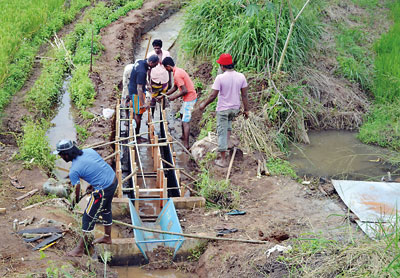
Village tank project provides lessons for restoration
People engaged in building an irrigation canal. Pic by Kumudu Herath@IUCN
By Malaka Rodrigo
Sri Lanka is famous for its irrigation heritage, but only the marvels of large tanks built for irrigation draw attention, while small village tanks are ignored. In many cases village tanks function as a ‘cascade system’ – so using wrong methods to restore them ignoring specific functions of associated components can do more harm, according to experts who discussed the issue recently in Colombo.
The experts say that in Sri Lanka’s dry zone there are 14,000 small ancient village tanks and many are in good shape, supporting 246,000 hectares, about 39 percent of the total irrigable area. In most cases these tanks are designed to function as interconnected clusters often referred to as ‘cascade systems’ called as ‘ellangawa’ in Sinhala.The International Union of Conservation of Nature and Department of Agrarian Development together with Bandaranaike Centre for International Studies, shared their experiences under the theme “ecological restoration and sustainable management of small tank cascade systems,” on February 14.
These tank cascade systems are identified as very efficient water management systems in the world with water being recycled in each tank without letting it go to waste. The entire tank system functions as a single unit, so restoring only a single tank is not useful, said IUCN’s Program Coordinator Shamen Vidanage.
Each tank in a given cascade system adopts geographical and functional features to harmonise with nature. The functional components of a tank perform specific purpose and roles of these components can even be explained in modern science although they were designed centuries ago, he added.
The first set of components of the cascade system is designed to improve the quality of water entering the tank from the catchment.
‘Kulu wewa’ also known as the ‘Forest Tank’ and water holes known as ‘harak wala’ and ‘goda wala’ are all located in the catchment of the tank, retaining dead leaves, mud and other debris, or sediment, experts explain. Next, before the tank is grass cover known as ‘perahana’ located between catchment and high flood levels for purifying the water by holding granules of earth, and sediment functioning similar to a preliminary treatment step of a modern waste water treatment system, the experts explain.
The water stored in the tank is protected from evaporation by tree belt naturally growing on either side of the uppermost areas of each tank. These are called ‘gasgommana’ acting as windshields minimising dry wind contacting the water surface minimizing evaporation, the experts note. “Kattakaduwa’ or interceptor, is a thick strip of vegetation located between tank bund and paddy fields. It also has a water hole called ‘yathuru wala’ to retain saline water seeping from the tank. Various plants of salt absorbing features are found on ‘kattakaduwawa’ which reduce the salinity of the water seeping through the bund before it reaches the paddy fields, the experts say.
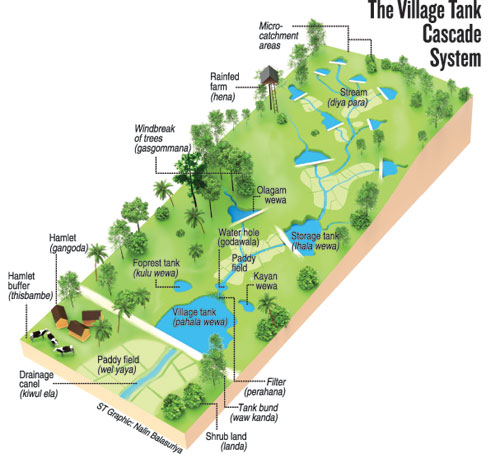 “Sadly the cascade systems are poorly understood. For example, there are instances that forest tanks have been used for irrigation,” Vidanage points out.
“Sadly the cascade systems are poorly understood. For example, there are instances that forest tanks have been used for irrigation,” Vidanage points out.
“Every village had a patch of forests called as ‘gam kele’ and that has disappeared as they are being encroached for agriculture. As a result of these wrong land use patterns, these small tanks now get more sedimentation, increasing tank siltation,” says Professor C M Madduma Bandara of the University of Peradeniya.
Tank sedimentation due to soil erosion is the main factor in the deterioration of the cascade system. Silted tanks retain less water and over the years, these tanks dry out and paddy fields are lost experts say. In addition, pesticides and fertilizers applied in upper areas pollutes the tank water without getting proper natural filtering mechanisms. So experts fear that in future, many of these tank cascade systems will deteriorate and will be abandoned owing to mismanagement.
Meanwhile, as a pilot project, IUCN partnered with Department of Agrarian Development to ecologically restore the Kapiriggama small tank cascade system in the Anuradhapura District. This three-year project was initiated in 2013 with financial assistance from the HSBC Water Programme.
Kapiriggama cascade is in the basin of Malwathuoya and consist of 21 tanks. During the project over 38,000 of cubic metres of silt was removed from five tanks in the Kapiriggama and the removed silt was deposited upstream IUCN says. The project also setup soil conservation mechanisms building soil conservation bunds. Over 7,500 plants on kattakaduwa on 13 tanks were also planted according to IUCN.
“We have also got community participation for all these tasks, so even when the project finishes the villagers who will benefit will be engaged making sure of the sustainability of the Kappirigama tank cascade system,” Dr Ananda Mallawatantri the Country Representative of IUCN said. The north central canal project can also use cascade systems in its design taking additional water into cascades before providing to paddy fields, Dr Mallawatantri said.
Source – 26/02/2017, The Sunday Times, See more at – http://www.sundaytimes.lk/170226/news/village-tank-project-provides-lessons-for-restoration-230491.html

Norochcholai coal plant toxic emissions under scrutiny
Harm caused to the ocean by the heated water released from the plant: Fishermen sort out the fish from marine life that have been destroyed and got caught in their nets. Pic by Hiran Priyankara.
By Anushiya Sathisraja
Deadly air pollution continues due to the misuse of air quality standrads by the Norochcholai coal power plant, experts say.
For too long power plants have used the environment like an open sewer for emissions. These emissions fuel climate change and also pose a serious threat to human health and the environment.
Air pollution downwind from a power plant depends on shifts in the air. On some days, there are hardly any fine particles that contribute to health problems such as asthma. On other days, there is more than twice as much. According to the National Environment Acts No 56 of 1988 and No 53 of 2000, obtaining the environmental protection licence from the Central Environmental Authority is mandatory for the power generation sector.
Along with the licence, the Norochcholai plant should also obtain the Certificate of Environmental Clearance for the coal-fired power plant since it is located in the Northwestern Provincial Council area.The CEA on March 1 will investigate the air pollution as well as the harm caused to the ocean by the heated water released, Acting Deputy General of Environment Pollution Control Division, Dr Sanjaya Ratnayake, said.
To manage the ambient air quality of the country, a project titled ‘Blue Sky 2020’, will be launched by year end, he said. “Its aims are to bring the country towards World Health Organisation interim targets by 2020,’’ he said. “The CEA is working with the health ministry to assess the trends and impact of air pollution in this regard.
Dr Ratnayake said various air pollutants across the country are being monitored. Secretary to the Ministry of Power and Renewable Energy, Dr D M S Batagoda said that, “some media often reports that farmers complain about the [coal] dust, but according to my knowledge their farming activities are taking place without any interruption”
Source – 26/02/2017,The Sunday Time, See more at – http://www.sundaytimes.lk/170226/news/norochcholai-coal-plant-toxic-emissions-under-scrutiny-230394.html

A dose of nature for better nealth At least 30 minutes a week
Today, half the world’s population, that is no less than 3.5 billion people, live in urban areas. The World Health Organization (WHO) identifies many issues related to water, environment, violence, injury, non-communicable diseases (cardiovascular diseases, cancers, diabetes and chronic respiratory diseases), unhealthy diets, physical inactivity, harmful use of alcohol and risks associated with disease outbreaks as health consequences of urbanization.
City living is associated with increased pressures of mass marketing, availability of unhealthy food choices and accessibility to automation and transport, all in turn having effects on lifestyle that directly affect health. But on the other hand, urbanization is ever increasing. Since Europe experienced an exodus of rural peasantry to the newly emerging city centers across Europe during the 18th and 19th centuries, the trend is still continuing all over the world. The estimates are that the world’s urban population will reach 70% mark by 2050.
All this happens not without a reason. Apart from the innumerable economic opportunities cities offer their dwellers – the “pull” factor that attracts people towards them – urban life can be rich and fulfilling since it is more diverse, stimulating, and full of new opportunities. Individual and family mobility make it easier to escape from oppressive social relationships. The Bull World Health Organ (short for Bulletin of World Health Organization) identifies cities as sources of ideas, energy, creativity, and technology, thus fostering enlightened, congenial, and multicultural living.
The European Journal of Public Health recognizes the lifestyle differences as the most striking feature of urbanization of today. As a result not only changes in food habits, physical activity, work patterns, smoking and alcohol consumption, but also changes in sexual behaviour, leisure time activities, and travelling patterns cause transitions in patterns of disease and mortality. In turn, most of these factors are especially associated with an increase in the risk of chronic diseases and some infectious diseases.
When things are such, the city dwellers invariably look for the options available for them to live healthy – physically, mentally and socially. Evidence is gathering from research across the world that nature helps our brains and bodies to stay healthy.
University of Queensland researchers from down under have come out with cutting edge research on how often and how intimately city dwellers need to engage with nature for them to be healthier. In the meantime, they have tried to answer the questions how frequently a person should visit nature and how long they should spend there to reap benefits like better state of mind and lower blood pressure. In short, the study results suggest we all may need a minimum dose of nature: 30 minutes in at least one visit a week.
Nature provides alterations to the physical environment, giving rise to a concept termed “biophysical ecosystem services”, which expects to reduce the health risks. The health impacts of biophysical ecosystems operate in a number of ways. For example, vegetation filters pollutants from the air and buffer the urban heat (island effect), thus, potentially reducing the prevalence of respiratory infections or heat-related illnesses. Nature’s influence on people’s lives by encouraging positive health behaviors include their more likelihood of exercising when the natural surroundings provide an interesting, pleasant, and safe environment. The aesthetically laid walking tracks, children’s parks and playgrounds are all good examples. Their positive impact on reducing obesity, diabetes, mental illness and other health issues associated with sedentary lifestyles goes without saying.
-kwk-3.jpg) Researchers have shown that exposure to nature can have restorative effects, potentially reducing the effects of stress in a person’s life. Most importantly, all these benefits of urban green space occur alongside a range of other positive outcomes that include biodiversity conservation and environmental sustainability.
Researchers have shown that exposure to nature can have restorative effects, potentially reducing the effects of stress in a person’s life. Most importantly, all these benefits of urban green space occur alongside a range of other positive outcomes that include biodiversity conservation and environmental sustainability.
In fact some experts believe nature to be the best antidote to 21st-century maladies like childhood obesity and even crime.
Source – 23/02 /20117 , The Island , See more at – http://www.island.lk/index.php?page_cat=article-details&page=article-details&code_title=160810
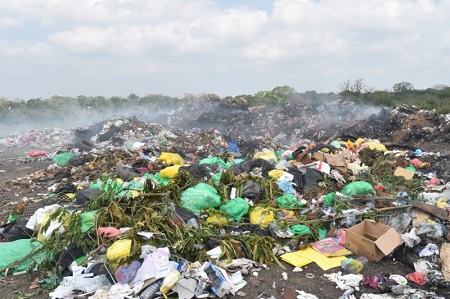
Health of Uni students, villagers threatened by Vavuniya garbage dump
The pratice of dumping garbage in the Puthiyasalampaikulam area in Pambaimadhu, Vavuniya for the past 15 years is causing severe health and environmental problems for area residents and university students.
About 5000 families living in close proximity to the site are affected by the garbage issue. The dump is also situated less than 500 meters from the premises of the University of Jaffna’s Vavuniya Campus. As a result, undergraduates at the campus face severe difficulties when engaged in sports or other outdoor activities due to the stench eminating from the dump and the fumes from fires set at the site.
About eight bowserloads and 10 tractorloads of garbage and waste are dumped at the site on a daily basis.
A child in the Pambaimadhu area was recently admitted to the Vavuniya General Hospital after falling severely ill. Doctors who examined him had concluded that he had suffered a respiratory illness after inhaling fumes that were the result of fires set at the garbage dump.
Area residents, frustrated by the failure of authorities to resolve the issue, planned to organize a protest on Monday regarding the matter. Upon learning of this, Minister Rishard Bathiudeen, who is also the Chairman of the Vavuniya District Development Committee, visited the area along with a team of officials. He directed officials to ensure that garbage does not get dumped continually at the site and to initiate a recycling program for garbage.
Story and Pix by Romesh Madushanka
Source – 22/02/2017,Times Online, See more at – http://www.sundaytimes.lk/article/1017343/health-of-uni-students-villagers-threatened-by-vavuniya-garbage-dump
















